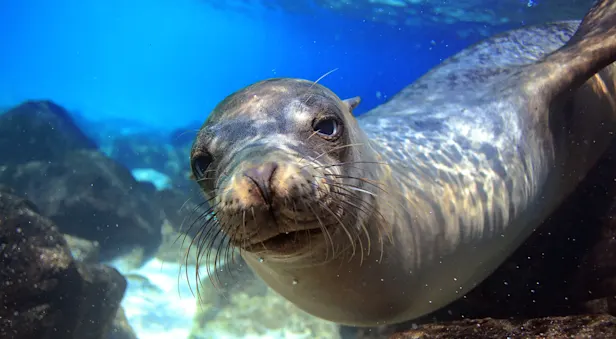Know Before You Go
Pacific Green Sea Turtle Facts | Galapagos Wildlife Guide
The Pacific green sea turtle breeds and lays eggs in the Galapagos, but it is not endemic to the islands. They are called “green” because of the color of their flesh.
Physical Characteristics
They are one of the largest of the turtle species, ranging from 2.5 to 5 feet in length and weighing up to 450 pounds
They have paddlelike limbs, the shape of which aids them in becoming proficient swimmers
The carapace, or upper side of the shell, can be olive to brown, or sometimes even black, depending on the geographic location of the species
Males are larger than females and have longer tails, which extend well beyond their shell.
Range and Habitat
Green sea turtles are highly migratory creatures. They range from Baja California south to the Galapagos and Peru and as far west as Hawaii and the Marshall Islands.
Behavior and Communication
Green sea turtles cannot pull their heads and limbs inside their shells, which makes them more vulnerable to predators. They come to Galapagos primarily to nest. But only females come ashore to lay eggs. Males remain submerged in the water most of their lives.
Feeding Habits
As juveniles, green sea turtles eat plants and other creatures such as jellyfish, crabs, snails and worms. As adults, they are strictly vegetarians and spend the majority of their time in the sea feeding on algae and on the grasses that grow in shallow waters.
Breeding and Reproduction
Green sea turtles are quite promiscuous during the breeding season, especially between November and January, when mating activity can often be observed in the water. Nesting occurs at night on many of the sandy beaches of the islands mainly from December to June, peaking in February. The female digs a hole in the sand above the high tide mark and deposits several dozen eggs, a process that takes about three hours. She then covers them with sand to protect them from the sun, heat and predators and returns to the ocean.
The newly laid eggs incubate in the sand for 50 to 60 days. The temperature of the nest determines the sex of the turtles, with cooler nests producing a clutch of males and, subsequently, warmer nests producing more females. On a clear, moonlit night, the hatchlings will dig themselves out of their nests and clamber toward the water.
Once away from the protection of their shells, they are extremely vulnerable to predation. Only 2 inches long, the tiny, helpless turtles have a treacherous journey, struggling to avoid ghost crabs, sea birds and fish on their way to the open ocean. Once they reach their destination, the turtles swim away for years. Almost nothing is known about this period of their lives, until they again return to nest at the same beach in which they were born.
Conservation
Green sea turtle hatchlings are often at great risk. Once hatched, they intuitively move toward the moonlight that reflects on the ocean surface, taking their lives into their own hands. Generally, other sources of light confuse them—they may move toward a house or streetlight instead—and they may never make it to the sea. Light sources such as these, or lack thereof, on many of the uninhabited Galapagos Islands help create a relatively safe environment for hatchlings.
Swim with Green Sea Turtles on These Galapagos Trips

Galapagos Discovery: The Nat Hab Experience
Small-group adventures aboard your choice of private yachts, led by our outstanding naturalist guides and photography pros. Snorkel and swim with sea lions, sea turtles and penguins on this incomparable nature odyssey.
























